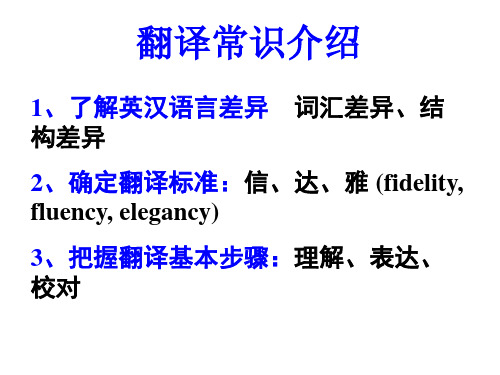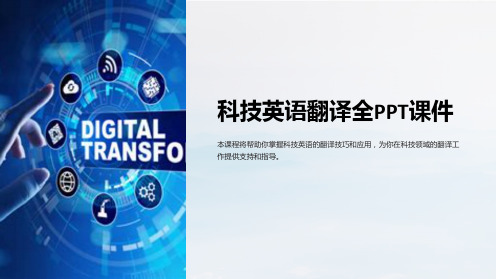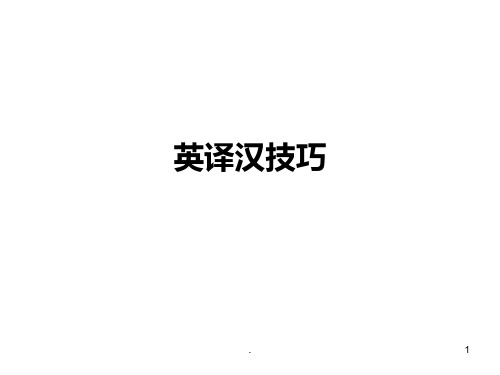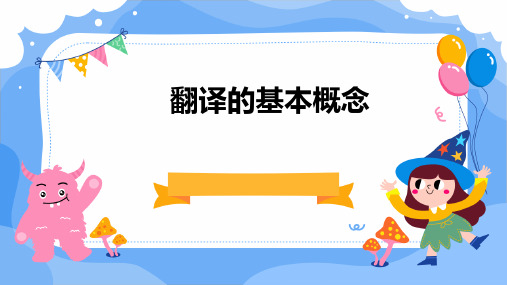翻译技术必要性.ppt
合集下载
翻译英语ppt课件

05
翻译工具与技术
机器翻译
01
02
03
自动翻译
机器翻译能够快速地将英 文PPT课件自动翻译成中 文,提高翻译效率。
多种语言支持
机器翻译支持多种语言之 间的翻译,满足不同语言 的需求。
简单易用
机器翻译操作简单,只需 要将英文PPT课件导入到 翻译工具中,即可快速得 到中文翻译结果。
在线翻译工具
在线实时翻译
意译
更注重传达原文的意义和精神,调整句式和表达方式,更符合目标语言的表达习 惯,适用于文化背景差异较大的文本。
增译与减译
增译
在翻译过程中,根据目标语言的表达习惯和语法规则,增加 一些词语或短语,以使译文更加流畅自然。
减译
在翻译过程中,适当省略原文中一些不必要的词语或表达方 式,使译文更加简洁明了。
词类转换
• 根据目标语言的语法规则和表达习惯,适当调整原文 中的词类,如名词、动词、形容词等,使译文更加符 合语法规范。
长句拆译
• 对于一些长句子的翻译,可以将其拆分成几个短句子,按照目标语言的表达习惯重新组织语序,使译文更加易于理解。
语序调整
• 根据目标语言的语法规则和表达习惯,适当调整原文中的 语序,使译文更加符合阅读习惯。
文化保真原则
保留文化元素
在翻译过程中,应尽量保留英文PPT课件中的文化元素,避免因文化差异造成 信息的损失。
尊重文化差异
对于文化差异的部分,应在保持原意的基础上进行适当的调整,以适应目标观 众的文化背景。
03
翻译技巧
直译与意译
直译
保留原文的句式和表达方式,尽量逐词翻译,适用于文化背景差异较小的文本。
解决方案
在翻译过程中,充分了解目标受众的文化背景和习惯,对具有文化特色的内容进行适当 的解释或调整,以帮助受众更好地理解。
论翻译的创造性PPt

追求行文流畅和节奏感
在保持语言流畅自然的同时,还应追求行文的流畅和节奏感,使译文读起来更加顺口、有韵律感。
04 创造性翻译的影响与价值
对文化交流的影响
促进文化理解
创造性翻译能够将原作的文化内涵准确传达 给目标语言读者,帮助他们更好地理解异域 文化,促进文化交流与融合。
打破文化障碍
创造性翻译能够化解文化冲突和误解,打破语言和 文化的障碍,让不同文化背景的人们能够相互理解 和沟通。
翻译时应注意保持原文的语言风格,包括语言特征、修辞手法和表达方式等, 以再现原作的艺术魅力。
传递原文的情感色彩
在保持原文语言风格的基础上,还应注重传递原文的情感色彩,使译文读者能 够感受到原作的情感表达和氛围。
语言流畅自然
符合目标语言的表达习惯
为了使译文流畅自然,翻译时应充分考虑目标语言的表达习惯,避免生硬直译,使译文更加地道、易 于理解。
丰富语言学习素材
创造性翻译可以提供丰富的语言学习素材和案例,帮助学习者更好地掌握语言的运用和表达技巧,提高 语言学习的效果和质量。
05 创造性翻译的挑战与未来 发展
翻译中的文化冲突与融合
文化差异
翻译过程中,源语言和目标语言之间的文化差异可能导致语义误 解或信息丢失。
文化融合
通过深入了解源语言和目标语言的文化背景,译者能够更好地传 达原文的意图和情感,实现文化融合。
感谢您的观看
风格再创造
不同作者的语言风格各异,译者 需在译作中创造性地再现原作的 风格特点,以使译作在风格上与 原作保持一致。
创造性翻译的实例
诗歌翻译
诗歌的语言凝练、含蓄、富有节奏感 ,要求译者在翻译过程中充分运用创 造性,再现原诗的意境、韵律和风格 。
小说翻译
在保持语言流畅自然的同时,还应追求行文的流畅和节奏感,使译文读起来更加顺口、有韵律感。
04 创造性翻译的影响与价值
对文化交流的影响
促进文化理解
创造性翻译能够将原作的文化内涵准确传达 给目标语言读者,帮助他们更好地理解异域 文化,促进文化交流与融合。
打破文化障碍
创造性翻译能够化解文化冲突和误解,打破语言和 文化的障碍,让不同文化背景的人们能够相互理解 和沟通。
翻译时应注意保持原文的语言风格,包括语言特征、修辞手法和表达方式等, 以再现原作的艺术魅力。
传递原文的情感色彩
在保持原文语言风格的基础上,还应注重传递原文的情感色彩,使译文读者能 够感受到原作的情感表达和氛围。
语言流畅自然
符合目标语言的表达习惯
为了使译文流畅自然,翻译时应充分考虑目标语言的表达习惯,避免生硬直译,使译文更加地道、易 于理解。
丰富语言学习素材
创造性翻译可以提供丰富的语言学习素材和案例,帮助学习者更好地掌握语言的运用和表达技巧,提高 语言学习的效果和质量。
05 创造性翻译的挑战与未来 发展
翻译中的文化冲突与融合
文化差异
翻译过程中,源语言和目标语言之间的文化差异可能导致语义误 解或信息丢失。
文化融合
通过深入了解源语言和目标语言的文化背景,译者能够更好地传 达原文的意图和情感,实现文化融合。
感谢您的观看
风格再创造
不同作者的语言风格各异,译者 需在译作中创造性地再现原作的 风格特点,以使译作在风格上与 原作保持一致。
创造性翻译的实例
诗歌翻译
诗歌的语言凝练、含蓄、富有节奏感 ,要求译者在翻译过程中充分运用创 造性,再现原诗的意境、韵律和风格 。
小说翻译
翻译中的语用学PPT课件

翻译中的语用学ppt课件
目录
• 翻译中的语用学概述 • 翻译中的语用学理论 • 翻译中的语用等效与语用对等 • 翻译中的语用失误与策略 • 翻译中的语用学实践案例分析
01 翻译中的语用学概述
定义与特点
定义
翻译中的语用学是一门研究翻译过程中语言使用和理解的学科,它关注语言在 实际语境中的意义和功能,以及翻译过程中如何准确传达这些意义和功能。
新闻报道的翻译案例分析
总结词
新闻报道的翻译需要准确、及时、客观,注 重语言的简练和清晰度。
详细描述
在新闻报道的翻译中,语用学可以帮助译者 更好地理解新闻报道中的语境和言外之意, 从而更准确地传达新闻的内容和意义。同时 ,语用学还可以帮助译者更好地把握新闻报 道中的语气和态度,从而更准确地传达新闻
中的意图和要求。
VS
发展方向
未来,翻译中的语用学研究将继续深入探 索语言使用和理解的规律,进一步拓展跨 文化交际的领域,并致力于提高翻译实践 的质量和效果。同时,随着人工智能和机 器翻译技术的发展,翻译中的语用学研究 也将与这些技术相结合,为翻译实践提供 更多的理论支持和指导。
02 翻译中的语用学理论
语境理论
总结词
文中以最相关的方式传达出来,以确保译文读者能够正确理解原文的含义。
礼貌原则
总结词
礼貌原则是语用学中的另一个重要理论,它 强调了语言交际中的礼貌和得体性。
详细描述
礼貌原则认为,人们在语言交际中应该遵循 一定的礼貌原则,以保持人际关系的和谐。 在翻译过程中,译者需要根据礼貌原则,对 原文进行适当的调整和改写,以确保译文更 加得体和礼貌。同时,译者还需要考虑译文 读者的文化背景和语言习惯,以确保译文更 加符合译文读者的期望和需求。
目录
• 翻译中的语用学概述 • 翻译中的语用学理论 • 翻译中的语用等效与语用对等 • 翻译中的语用失误与策略 • 翻译中的语用学实践案例分析
01 翻译中的语用学概述
定义与特点
定义
翻译中的语用学是一门研究翻译过程中语言使用和理解的学科,它关注语言在 实际语境中的意义和功能,以及翻译过程中如何准确传达这些意义和功能。
新闻报道的翻译案例分析
总结词
新闻报道的翻译需要准确、及时、客观,注 重语言的简练和清晰度。
详细描述
在新闻报道的翻译中,语用学可以帮助译者 更好地理解新闻报道中的语境和言外之意, 从而更准确地传达新闻的内容和意义。同时 ,语用学还可以帮助译者更好地把握新闻报 道中的语气和态度,从而更准确地传达新闻
中的意图和要求。
VS
发展方向
未来,翻译中的语用学研究将继续深入探 索语言使用和理解的规律,进一步拓展跨 文化交际的领域,并致力于提高翻译实践 的质量和效果。同时,随着人工智能和机 器翻译技术的发展,翻译中的语用学研究 也将与这些技术相结合,为翻译实践提供 更多的理论支持和指导。
02 翻译中的语用学理论
语境理论
总结词
文中以最相关的方式传达出来,以确保译文读者能够正确理解原文的含义。
礼貌原则
总结词
礼貌原则是语用学中的另一个重要理论,它 强调了语言交际中的礼貌和得体性。
详细描述
礼貌原则认为,人们在语言交际中应该遵循 一定的礼貌原则,以保持人际关系的和谐。 在翻译过程中,译者需要根据礼貌原则,对 原文进行适当的调整和改写,以确保译文更 加得体和礼貌。同时,译者还需要考虑译文 读者的文化背景和语言习惯,以确保译文更 加符合译文读者的期望和需求。
汉译英翻译技巧PPT课件

汉译英翻译技巧
Sub Title here
1
一)词的翻译
• >>1.词义选择 • (1)语境词 • 例子: • 原句:手机刷新了人与人的关系。
• 译文:Cell phone have altered the
relationship among people. • 分析:“刷新”此处实际是指“改变”,
4
一)词的翻译
• >>3.词的增补 • (1)语法需要 • (2)意思表达需要 • (3)文化背景解释的需要
• >>4.词的减省 • >>5.词的代替(用代词代替重复的部分)
5
二)句的翻译
• >> 1)确立主干 • (1)确定主语 • 例文:这个地方比较多雨。 • 译文1:It rains a lot in this area. • 译文2:This area sees much rain. • 译文3:There is much rain in this area. • 分析:汉语主语的角度变化很少,而英语则变化
12
写在最后
成功的基础在于好的学习习惯
The foundation of success lies in good habits
13
结束语
当你尽了自己的最大努力时,失败也是伟大的, 所以不要放弃,坚持就是正确的。
When You Do Your Best, Failure Is Great, So Don'T Give Up, Stick To The End 演讲人:XXXXXX 时 间:XX年XX月XX日
2)段落的连贯 段落的连贯(coherence)指的是内容情节的 串联,或者逻辑关系上的贯通,总得来说 就是有完整的语义关系。
Sub Title here
1
一)词的翻译
• >>1.词义选择 • (1)语境词 • 例子: • 原句:手机刷新了人与人的关系。
• 译文:Cell phone have altered the
relationship among people. • 分析:“刷新”此处实际是指“改变”,
4
一)词的翻译
• >>3.词的增补 • (1)语法需要 • (2)意思表达需要 • (3)文化背景解释的需要
• >>4.词的减省 • >>5.词的代替(用代词代替重复的部分)
5
二)句的翻译
• >> 1)确立主干 • (1)确定主语 • 例文:这个地方比较多雨。 • 译文1:It rains a lot in this area. • 译文2:This area sees much rain. • 译文3:There is much rain in this area. • 分析:汉语主语的角度变化很少,而英语则变化
12
写在最后
成功的基础在于好的学习习惯
The foundation of success lies in good habits
13
结束语
当你尽了自己的最大努力时,失败也是伟大的, 所以不要放弃,坚持就是正确的。
When You Do Your Best, Failure Is Great, So Don'T Give Up, Stick To The End 演讲人:XXXXXX 时 间:XX年XX月XX日
2)段落的连贯 段落的连贯(coherence)指的是内容情节的 串联,或者逻辑关系上的贯通,总得来说 就是有完整的语义关系。
英语翻译常识介绍PPT课件

2)词序上的差异
英语句中单词修饰语一般放在中心词前面,短语 和从句一般放在中心词后面,汉语定语无论单词 还是词组一般放在中心词前面;英语的谓词状语 一般可出现在动词前后,汉语的谓词状语常在动 词之前;英语中叙述和说明事物时,习惯于从小 到大,从特殊到一般,从个体到整体,从近到远。 汉语的顺序一般则是从大到小,从一般到特殊, 从整体到个体,从远到近,两者顺序完全相反。
2)静态与动态
英语是屈折语(inflectional language),汉语 是非屈折语(non inflectional language),相 对而言,英语语言形态丰富。动词形态变化繁 复,这就使英语动词的使用受形态的牵制,而 名词就没有这个问题,因此名词在英语中占优 势,名词的优势导致了介词的伴随优势。汉语 词类没有形态变化问题。而动词与名词比较, 动词的动态感强,名词则较为凝滞,所以在汉 语中动词极为活跃。
英语中的连词和介词的使用频率比汉语中更
高;英汉语言都有许多相同的构词手段,但
重叠法汉语常用,如千千万万、家家户户、
干干净净等,英语罕用;英语的典型特征是
词缀丰富,汉语的典型特征是形态变化少;
英语多代词,汉语多实称;英语多变化,力
戒重复,常常用替代、省略和变换的表达方
法避免重复。汉语用词不怕重复,常常运用 实称、还原、复说的表达方法。如:He hated failure,he had conquered it all his life,risen above it , despised it in others. 他讨厌失败,他一生曾战胜失败, 超越失败,并且藐视别人的失败。
Here at home in England, under the fire of the Germany, we do not forget the ties and links unite us to France, and we are persevering steadfastly and in good heart in the cause of European freedom and fair dealing for the common people of all countries, for which, with you, we drew the sword.
《科技英语翻译全》课件

科技发展
展望科技的未来发展,探讨翻译 面临的新挑战。
翻译技术
介绍新兴的翻译技术和对科技英 语翻译的影响。
跨文化交流
探讨跨文化交流对科技英语翻译 的要求和挑战。
科技英语翻译的成功案例
1
医学文章翻译
一篇医学文章的翻译,通过对领域专业术语的把握,确保了翻译准确无误。
2
科技公司介绍翻译
一份科技公司介绍的翻译,通过运用生动形象的语言和西方文化的巧妙结合,打 造了一份令人眼前一亮的翻译文本。
3
技术培训材料翻译
一份技术培训材料的翻译,通过精细的翻译工作和清晰的语言表达,帮助受众理 解培训内容,提高了学习质量。
常见错误和纠正方法
错误:术语错误或翻 译不准确
纠正方法:积累科技英语术语, 注意专业性,加强文本校对。
错误:语言文法错误 或语序不恰当
纠正方法:学习技术英语语法 和逻辑,查阅规范化语言建议。
错误:缺乏专业性或 文化差异
纠正方法:了解行业文化背景 和技术特点,加强专业知识学 习。
科技英语翻译的未来展望
科技英语翻译全PPT课件
本课程将帮助你掌握科技英语的翻译技巧和应用,为你在科技领域的翻译工 作提供支持和指导。
课程大纲
第一部分:技术英语翻 译定义
探讨技术英语翻译的定义和 基本要求。
第二部分:基础语法和 翻译技巧
介绍科技英语翻译中的基础 语法和翻译技巧。
Hale Waihona Puke 第三部分:科技英语翻 译的挑战
分析科技英语翻译的难点和 挑战。
科技英语翻译的应用
医疗技术
介绍医疗技术领域的英语翻译应 用。
人工智能
探讨人工智能领域的英语翻译应 用。
能源技术
《大学英汉翻译》课件

将理解后的意思用目标语言表达出来,注意语言的流畅性和准
确性。
校对
03
对译文进行校对和润色,确保译文的准确性和表达的流畅性。
02 英汉语言对比
词汇对比
总结词
词汇差异、词义对应、一词多义、词汇空缺
详细描述
英汉两种语言在词汇层面存在显著差异,一些英语词汇在汉语中没有直接对应的表达,反之亦然。在翻译过程中 ,需要深入理解词汇的内涵和外延,寻找最贴切的汉语表达。此外,一词多义和词汇空缺也是英汉翻译中常见的 现象,需要结合语境和专业知识进行准确翻译。
翻译的种类
包括口译、笔译、机器翻译 等。
翻译的标准
准确性
译文应准确传达原文的意思,避免歧义和误解 。
流畅性
译文应流畅自然,易于理解,符合目标语言的 表达习惯。
风格
译文应保持原文的风格和修辞特点,以传达原文的艺术效果。
翻译的过程
理解
01
准确理解原文的意思和语境,包括词汇、语法、文化背景等。
表达
02
《大学英汉翻译》ppt课件
目录
• 翻译概述 • 英汉语言对比 • 翻译技巧 • 翻译实践 • 翻译中的常见错误 • 翻译工具与资源
01 翻译概述
翻译的定义
ቤተ መጻሕፍቲ ባይዱ
翻译定义
翻译是将一种语言的信息用 另一种语言表达出来,以实 现跨语言沟通的过程。
翻译的本质
翻译不仅仅是语言的转换, 更是文化的传递和思想的交 流。
总结词
强调格式和行文规范
详细描述
商务翻译需遵循一定的格式和行文规范,符合商业信函、 合同、协议等文体的要求,用词规范、表达清晰,使译文 具有法律效力。
总结词
关注商业文化和谈判技巧
翻译报告-论文翻译PPT课件

术语背景知识
了解相关领域的背景知识,以便更准确地理解和 翻译专业术语。
长句翻译问题
句子结构分析
01
对长句进行结构分析,理清句子主干和修饰成分,以便更准确
地传达原文意思。
语言表达流畅性
02
在保持原文意思的基础上,调整句子结构,使目标语言的表达
更加流畅自然。
语境理解
03
结合上下文语境理解长句意思,避免因脱离语境而导致的误译。
Part
04
翻译技巧与策略应用
词义选择技巧
根据上下文语境选择词义
在翻译过程中,同一个单词在不同语境下可能有不同的含义,需 要根据化较多,而汉语中相对较少。在翻译时,需要根据目 标语言的表达习惯,灵活地进行词性转换。
掌握专业术语
在学术论文翻译中,涉及大量专业术语。准确理解和翻译这些术语 对于保证译文质量至关重要。
学术论文翻译涉及语言学、文化学、专业 领域知识等多个方面,未来可以加强跨学 科合作,共同推动学术论文翻译的发展。
THANKS
感谢您的观看
翻译报告-论文翻译 ppt课件
• 引言 • 翻译过程概述 • 原文与译文对比分析 • 翻译技巧与策略应用 • 翻译难点与问题探讨 • 总结与展望
目录
Part
01
引言
报告目的和背景
目的
本报告旨在介绍论文翻译ppt课件的制作过程、翻译技巧及注意事项,帮助读者更好地理 解和应用论文内容。
背景
随着国际学术交流的日益频繁,论文翻译成为促进学术传播的重要手段。ppt课件作为一 种直观、生动的展示方式,在学术报告中具有重要地位。因此,制作高质量的论文翻译 ppt课件对于提升学术交流效果具有重要意义。
文化背景知识运用
了解相关领域的背景知识,以便更准确地理解和 翻译专业术语。
长句翻译问题
句子结构分析
01
对长句进行结构分析,理清句子主干和修饰成分,以便更准确
地传达原文意思。
语言表达流畅性
02
在保持原文意思的基础上,调整句子结构,使目标语言的表达
更加流畅自然。
语境理解
03
结合上下文语境理解长句意思,避免因脱离语境而导致的误译。
Part
04
翻译技巧与策略应用
词义选择技巧
根据上下文语境选择词义
在翻译过程中,同一个单词在不同语境下可能有不同的含义,需 要根据化较多,而汉语中相对较少。在翻译时,需要根据目 标语言的表达习惯,灵活地进行词性转换。
掌握专业术语
在学术论文翻译中,涉及大量专业术语。准确理解和翻译这些术语 对于保证译文质量至关重要。
学术论文翻译涉及语言学、文化学、专业 领域知识等多个方面,未来可以加强跨学 科合作,共同推动学术论文翻译的发展。
THANKS
感谢您的观看
翻译报告-论文翻译 ppt课件
• 引言 • 翻译过程概述 • 原文与译文对比分析 • 翻译技巧与策略应用 • 翻译难点与问题探讨 • 总结与展望
目录
Part
01
引言
报告目的和背景
目的
本报告旨在介绍论文翻译ppt课件的制作过程、翻译技巧及注意事项,帮助读者更好地理 解和应用论文内容。
背景
随着国际学术交流的日益频繁,论文翻译成为促进学术传播的重要手段。ppt课件作为一 种直观、生动的展示方式,在学术报告中具有重要地位。因此,制作高质量的论文翻译 ppt课件对于提升学术交流效果具有重要意义。
文化背景知识运用
科技文体的翻译PPT课件

案例分析
以某篇科技广告的翻译为例,展示如何准确传达原文的 含义,如何处理复杂的逻辑关系和句式结构,以及如何 保持原文的风格和语气。
04
科技文体翻译的挑战与解决方案
文化差异的挑战与解决方案
挑战
不同文化背景下,人们对科技概念的 理解和表达方式可能存在差异,这可 能导致翻译时出现歧义或误解。
解决方案
在翻译过程中,应充分了解目标文化 的科技语境和表达习惯,采用适当的 语言和表述方式,以使译文更加贴切 和易于理解。
解决方案
在翻译过程中,应仔细阅读原文,充分理解上下文和背景信息,以确保译文与原文的语境一致。同时,在必要的 情况下,可以与原文作者进行沟通,以更好地理解原文的意图和语境。
05
科技文体翻译的未来发展趋势
人工智能在科技文体翻译中的应用
人工智能技术已广泛应用于科 技文体翻译,如机器翻译、自 然语言处理等,提高了翻译效
案例分析
以某篇科技文献的翻译为例,展示如何准确 翻译专业术语,如何处理复杂句式和长句结
构,以及如何保持原文的风格和语气。
科技论文的翻译实践
科技论文的翻译实践
科技论文通常具有严谨的结构和逻辑关系,因此在翻译过程中需要特别注意保持这些特 点。在词汇选择上,需要准确表达原文的含义,避免使用模糊或歧义的词汇。在句式结
率和准确性。
人工智能技术能够快速处理 大量数据,进行语义分析和 语境推断,使译文更加贴切
自然。
人工智能技术还有助于提高多 语言翻译的同步性和一致性, 为跨国企业和国际交流提供更
好的语言服务。
跨文化交流对科技文体翻译的影响
随着全球化的深入发展,跨文化交流成为科技文体翻译的重要背景,要求译者在传递科技信息的同时, 兼顾不同文化背景和语言习惯。
英译汉翻译技巧必看PPT课件

• 他三岁丧父,所以记不起父亲了。
• Strange enough they were the same age to the day.
• 说来也巧, 他俩年纪一样大, 而且还是同 日的。
.
15
5.合译法
• 合译是将原文的两个或几个分开叙述的意 思或层次合并重组,如将两个分句合译为 一个简单句,或两个简单句合译成一个复 合句等, 使全句的结构更加紧凑,语气更 加顺通。
• 直译: 好的婚姻不会仅仅发生—它们需要 大量的爱和大量的工作。
• 意译:幸福的婚姻不是凭空发生的---它需 要你为它付出大量的爱和做大量的工作。
• 或:美满的婚姻不会从天上掉下来---你必 须为它付出大量的爱,做大量的工作。
.
5
• 很显然,本句话的意译要比直译更符合汉 语表达习惯。当然,一句话并不限于一种 译法,要根据具体需要而定。一般来说, 在英汉翻译考试中,如果直译能达意就用 直译,如果直译效果不好,就应该考虑意 译。只要译文内容忠实,意思明白就行了。
• The electronic computer is chiefly characterized by its accurate and rapid computation.
• 计算机的主要特点是计算准确迅速。
.
21
3.英语名词→汉语形容词
• 英语原文中有形容词加后缀构成的名词, 翻译时可转化为汉语的形容词。 如:
• He came to my home for help. • 他来到我家请求帮助。 • I love having Friday off. • 我喜欢周五休息。 • I am for the former. • I am against the latter.
• Strange enough they were the same age to the day.
• 说来也巧, 他俩年纪一样大, 而且还是同 日的。
.
15
5.合译法
• 合译是将原文的两个或几个分开叙述的意 思或层次合并重组,如将两个分句合译为 一个简单句,或两个简单句合译成一个复 合句等, 使全句的结构更加紧凑,语气更 加顺通。
• 直译: 好的婚姻不会仅仅发生—它们需要 大量的爱和大量的工作。
• 意译:幸福的婚姻不是凭空发生的---它需 要你为它付出大量的爱和做大量的工作。
• 或:美满的婚姻不会从天上掉下来---你必 须为它付出大量的爱,做大量的工作。
.
5
• 很显然,本句话的意译要比直译更符合汉 语表达习惯。当然,一句话并不限于一种 译法,要根据具体需要而定。一般来说, 在英汉翻译考试中,如果直译能达意就用 直译,如果直译效果不好,就应该考虑意 译。只要译文内容忠实,意思明白就行了。
• The electronic computer is chiefly characterized by its accurate and rapid computation.
• 计算机的主要特点是计算准确迅速。
.
21
3.英语名词→汉语形容词
• 英语原文中有形容词加后缀构成的名词, 翻译时可转化为汉语的形容词。 如:
• He came to my home for help. • 他来到我家请求帮助。 • I love having Friday off. • 我喜欢周五休息。 • I am for the former. • I am against the latter.
翻译的可行性(不可行性)

语音差异
语音是语言的物质外壳,不同语言之间的语音系 统存在显著的差异,包括音位、音调和重音等。
文化背景对翻译的影响
文化内涵词
01
某些词汇在特定文化中具有独特的内涵和意义,这些
词汇在另一种文化中可能无法找到完全对应的表达。
习俗与价值观
02 不同文化之间的习俗和价值观差异可能导致翻译过程
中的误解和冲突。
探讨不可行性因素
识别并分析影响翻译可行性的关 键因素,如技术局限性、文化差 异、语言复杂性等,为行业发展 提供参考。
提出建议与展望
基于分析结果,提出针对性的建 议和改进措施,展望翻译行业未 来的发展趋势和前景。
02
翻译的定义与分类
翻译的定义
语言转换
翻译是将一种语言中的文本或口头表 达转换为另一种语言的过程,涉及对 原文的理解和用另一种语言的再表达 。
历史背景
03
历史事件和人物在不同文化中的认知和评价可能存在
差异,影响翻译的准确性和可接受性。
翻译过程中的信息损失
语义损失
01
由于语言之间的差异,某些原文中的语义信息可Leabharlann 在翻译过程中无法完全传达。
风格损失
02
原文的风格和特点可能在翻译过程中被削弱或改变,导致译文
与原文在风格上不一致。
语境损失
03
原文所处的语境和背景信息可能在翻译过程中被忽略或简化,
多语言需求
全球范围内存在众多语言,不同语 言之间的翻译需求不断增长,为翻 译行业提供了广阔的市场空间。
技术发展
近年来,人工智能、机器学习等技 术的快速发展为翻译行业带来了新 的机遇和挑战。
报告目的
分析翻译的可行性
通过对当前翻译技术、市场需求 、行业现状等方面的深入分析, 探讨翻译的可行性及潜在风险。
语音是语言的物质外壳,不同语言之间的语音系 统存在显著的差异,包括音位、音调和重音等。
文化背景对翻译的影响
文化内涵词
01
某些词汇在特定文化中具有独特的内涵和意义,这些
词汇在另一种文化中可能无法找到完全对应的表达。
习俗与价值观
02 不同文化之间的习俗和价值观差异可能导致翻译过程
中的误解和冲突。
探讨不可行性因素
识别并分析影响翻译可行性的关 键因素,如技术局限性、文化差 异、语言复杂性等,为行业发展 提供参考。
提出建议与展望
基于分析结果,提出针对性的建 议和改进措施,展望翻译行业未 来的发展趋势和前景。
02
翻译的定义与分类
翻译的定义
语言转换
翻译是将一种语言中的文本或口头表 达转换为另一种语言的过程,涉及对 原文的理解和用另一种语言的再表达 。
历史背景
03
历史事件和人物在不同文化中的认知和评价可能存在
差异,影响翻译的准确性和可接受性。
翻译过程中的信息损失
语义损失
01
由于语言之间的差异,某些原文中的语义信息可Leabharlann 在翻译过程中无法完全传达。
风格损失
02
原文的风格和特点可能在翻译过程中被削弱或改变,导致译文
与原文在风格上不一致。
语境损失
03
原文所处的语境和背景信息可能在翻译过程中被忽略或简化,
多语言需求
全球范围内存在众多语言,不同语 言之间的翻译需求不断增长,为翻 译行业提供了广阔的市场空间。
技术发展
近年来,人工智能、机器学习等技 术的快速发展为翻译行业带来了新 的机遇和挑战。
报告目的
分析翻译的可行性
通过对当前翻译技术、市场需求 、行业现状等方面的深入分析, 探讨翻译的可行性及潜在风险。
功能翻译翻译目的论简介课件

目的论强调翻译过程中的动态性,但 在实际操作中,如何准确把握原文意 图并实现动态转换是一大挑战。
语言多样性
全球语言的多样性给目的论的实践带 来挑战,不同语言的语法、语义和表 达方式需要针对具体情况进行调整。
目的论的发展趋势
跨学科融合
随着语言学、文化学、传播学等 学科的不断发展,目的论将进一 步融入相关学科理论,丰富和发
目的论认为翻译时应保留原文本
的主要功能,如信息传递、表达
03
情感或说服读者等。
适应性选择
04 目的论认为译者应根据翻译的目 的和文本功能进行适应性选择, 选择最合适的翻译方法和策略。
02
功能翻译翻译目的论的原则
目的原 则
目的原则是功能翻译翻译 目的论的首要原则,它强 调翻译应以实现预期目的 为首要任务。
详细描述
在广告文本翻译中,译者需要充分考虑目标受众的文化背景和语言习惯,采用生动、形 象的语言表达方式,突出产品的特点和优势,以吸引目标受众的注意力并激发其购买欲 望。同时,译者还需要注意语言的简洁明了,避免使用过于复杂或难以理解的词汇和表
达方式。
案例二:法律文本翻译的准确性分析
总结词
法律文本翻译的准确性至关重要,需要 确保原文的含义在目标语言中得到准确 传达。
总结词
准确传达信息
详细描述
法律文本的翻译应以准确传达信息为主要目的,注重语言的规范性和严谨性,强 调语义的准确性和一致性,以确保法律条款的准确理解和执行。Leabharlann 旅游文本的翻 译总结词
传递文化信息
详细描述
旅游文本的翻译应以传递文化信息为主要目的,注重语言的形象性和生动性,强调景点的历史和文化背景的介绍, 以帮助游客更好地了解和体验旅游目的地。
翻译的可行性(不可行性)PPT课件

6
可译性:
语言是思维的各种不同的工具和外壳,但 是思维的基础是现实,思维是统一的,不管 人们所利用的语言如何不同,它们总是反映 出实际生活,这就是说,各种不同的语言可 以反映出同样的实际。因此,人们用一种语 言表达出来的内容,也是可以用另外一种语 言来表达的,这就是可译性的依据。
诗歌的可译性
习语的可译性
人同此心,心同此理
4
翻译可行性实例:
语内翻译:古典诗词、名著等的翻译
(e.g.唐诗宋词、四书五经、《史记》、四大名著等)
语际翻译: 国外文学作品、宗教著作、政治经济科技等领域
专著
(e.g.《哈姆雷特》、《圣经》、《共产党宣言》、《资本 论》、医疗科学技术等)
5
翻译的不可行性:
尼古拉·鲁巴金认为一部书只不过是读者 思维的外部投射,无论何时有必要抛弃一个 十分普遍的观念,那就是每一部书都有它自 身的内容,且这一内容都可以在阅读的时候 传达给任何一位读者。
1)A: What makes a road broad? B: The letter B.
2) A: Why is the letter D like a bad boy? B: Because it makes ma mad. 句中“road,broad,ma,mad” 不仅起一般词形的形式作用,而且是作为内容出现的.句 中“road”,“broad”和“B”都无法译成汉语.如当 英语语言形式本身充当内容时.不可译现象就可能出现.此 外,还有与语言父字的形式特点有关的不可译现象。这 类现象大多是利用语言文字的形式特点达到某种修辞效 14 果。
文体的可译性
风格的可译性
7
诗歌的可译性:
诗歌是文学作品的一种形式,也有人认为是文学作品的 最高形式,有翻译家认为诗歌是根本无法翻译的,提出了 诗歌的不可译理论(nontranslatability of poetry).这种说 法未免过于绝对化,是不符合实际的。各国 的诗歌虽然所用的语言不同,但是诗人的灵感却是息息相 通,并不受国界的限制的。只要对原诗的思想、感情、意 境、韵味有深切的感受,引起心灵的共鸣,同时,对于本 国语言及其韵律又能够很好地掌握,运用自如,并不是不 可能的。
可译性:
语言是思维的各种不同的工具和外壳,但 是思维的基础是现实,思维是统一的,不管 人们所利用的语言如何不同,它们总是反映 出实际生活,这就是说,各种不同的语言可 以反映出同样的实际。因此,人们用一种语 言表达出来的内容,也是可以用另外一种语 言来表达的,这就是可译性的依据。
诗歌的可译性
习语的可译性
人同此心,心同此理
4
翻译可行性实例:
语内翻译:古典诗词、名著等的翻译
(e.g.唐诗宋词、四书五经、《史记》、四大名著等)
语际翻译: 国外文学作品、宗教著作、政治经济科技等领域
专著
(e.g.《哈姆雷特》、《圣经》、《共产党宣言》、《资本 论》、医疗科学技术等)
5
翻译的不可行性:
尼古拉·鲁巴金认为一部书只不过是读者 思维的外部投射,无论何时有必要抛弃一个 十分普遍的观念,那就是每一部书都有它自 身的内容,且这一内容都可以在阅读的时候 传达给任何一位读者。
1)A: What makes a road broad? B: The letter B.
2) A: Why is the letter D like a bad boy? B: Because it makes ma mad. 句中“road,broad,ma,mad” 不仅起一般词形的形式作用,而且是作为内容出现的.句 中“road”,“broad”和“B”都无法译成汉语.如当 英语语言形式本身充当内容时.不可译现象就可能出现.此 外,还有与语言父字的形式特点有关的不可译现象。这 类现象大多是利用语言文字的形式特点达到某种修辞效 14 果。
文体的可译性
风格的可译性
7
诗歌的可译性:
诗歌是文学作品的一种形式,也有人认为是文学作品的 最高形式,有翻译家认为诗歌是根本无法翻译的,提出了 诗歌的不可译理论(nontranslatability of poetry).这种说 法未免过于绝对化,是不符合实际的。各国 的诗歌虽然所用的语言不同,但是诗人的灵感却是息息相 通,并不受国界的限制的。只要对原诗的思想、感情、意 境、韵味有深切的感受,引起心灵的共鸣,同时,对于本 国语言及其韵律又能够很好地掌握,运用自如,并不是不 可能的。
时政翻译课件ppt

详细描述
在时政翻译中,译者应充分理解原文含义,注意语言细节和语境背景,使用准确、规范的词汇和表达方式。同时 ,还需注意政治敏感性,避免因语言差异或文化背景不同而引起的歧义或误解。
02
时政翻译技巧
词汇选择与翻译
总结词
准确、专业、地道
详细描述
在时政翻译中,词汇的选择至关重要。译者应准确理解 原文含义,选用专业、地道的词汇进行翻译,确保信息 的准确传递。
总结词
注重文化差异、避免文化冲突
详细描述
由于文化背景的差异,相同的词汇或表达方式在不同语言 中可能具有不同的文化内涵。译者应充分了解两种文化背 景,注重文化差异,避免因文化冲突导致误解或冒犯。
总结词
传播文化信息、促进文化交流
详细描述
时政翻译不仅是语言之间的转换,更是文化信息的传播。 译者应以跨文化的视角进行翻译,准确传达原文的文化内 涵,促进不同文化之间的交流与理解。
04
时政翻译案例分析
领导人演讲的翻译案例
总结词
领导人演讲的翻译需要准确传达领导人的思 想和意图,同时要符合目标语言的表达习惯 和规范。
详细描述
在领导人演讲的翻译中,要特别注意语言的 正式程度、语气和措辞,以确保准确传达领 导人的意图和思想。同时,要注意目标语言 的表达习惯和规范,避免出现语法错误、语 义模糊或表达不当的情况。
应对策略
加强跨文化学习和交流,提高跨文化意识和敏感性;在翻译过程中,注重对比不同文化的表达方式,选 择最合适的表达方式;注重与目标受众沟通交流,了解其文化背景和价值观。
政治敏感性的挑战与对策
总结词
详细描述
政治敏感性是时政翻译中最为重要的 因素之一,要求译者具备高度的政治 敏感性和责任心。
在时政翻译中,译者应充分理解原文含义,注意语言细节和语境背景,使用准确、规范的词汇和表达方式。同时 ,还需注意政治敏感性,避免因语言差异或文化背景不同而引起的歧义或误解。
02
时政翻译技巧
词汇选择与翻译
总结词
准确、专业、地道
详细描述
在时政翻译中,词汇的选择至关重要。译者应准确理解 原文含义,选用专业、地道的词汇进行翻译,确保信息 的准确传递。
总结词
注重文化差异、避免文化冲突
详细描述
由于文化背景的差异,相同的词汇或表达方式在不同语言 中可能具有不同的文化内涵。译者应充分了解两种文化背 景,注重文化差异,避免因文化冲突导致误解或冒犯。
总结词
传播文化信息、促进文化交流
详细描述
时政翻译不仅是语言之间的转换,更是文化信息的传播。 译者应以跨文化的视角进行翻译,准确传达原文的文化内 涵,促进不同文化之间的交流与理解。
04
时政翻译案例分析
领导人演讲的翻译案例
总结词
领导人演讲的翻译需要准确传达领导人的思 想和意图,同时要符合目标语言的表达习惯 和规范。
详细描述
在领导人演讲的翻译中,要特别注意语言的 正式程度、语气和措辞,以确保准确传达领 导人的意图和思想。同时,要注意目标语言 的表达习惯和规范,避免出现语法错误、语 义模糊或表达不当的情况。
应对策略
加强跨文化学习和交流,提高跨文化意识和敏感性;在翻译过程中,注重对比不同文化的表达方式,选 择最合适的表达方式;注重与目标受众沟通交流,了解其文化背景和价值观。
政治敏感性的挑战与对策
总结词
详细描述
政治敏感性是时政翻译中最为重要的 因素之一,要求译者具备高度的政治 敏感性和责任心。
翻译的基本概念

减译
在翻译过程中,适当省略一些不必要 的词汇或短语,以使译文更加简洁、 明了。
词类转换与语序调整
词类转换
在翻译过程中,根据目标语言的表达习惯和语法规则,对原文中的词类进行适当的转换。
语序调整
在翻译过程中,根据目标语言的表达习惯和语法规则,对原文的语序进行适当的调整。
04
翻译中的难点与应对策略
文化差异的处理
VS
商务报告也是商务翻译中的重要一环。 商务报告是公司或机构为了向内部或 外部报告某项业务或项目的情况而撰 写的文件。在商务报告翻译中,译者 需要充分理解报告的内容和语言特点, 同时注重语言的简洁性和条理性,以 使读者能够快速了解报告的核心内容。
技术翻译案例
在技术翻译中,产品说明书是一个常见的领域。产品说明书是介绍产品功能、使用方法、注意事项等 信息的文件。在产品说明书翻译中,译者需要充分了解产品的特点和功能,同时注重语言的通俗性和 实用性,以确保用户能够正确使用产品。
专业翻译软件
专业术语
专业翻译软件通常针对特定领域或行业,提供更加准确和专业的 翻译服务。
高质量输出
专业翻译软件注重翻译的准确性和流畅性,确保输出的译文质量 较高。
定制化服务
专业翻译软件可以根据用户需求提供定制化的翻译服务,如个性 化术语库、专业排版等。
06
翻译实践与案例分析
文学翻译案例
《红楼梦》是清代作家曹雪芹所著的一部长篇小说,被誉为中国四大名著之一。该小说被翻译成多种语言,其中最著名的是 杨宪益和戴乃迭的英译本。在文学翻译中,译者需要充分理解原作的文化背景和深层含义,同时注重语言的流畅性和美感, 以传达原著的艺术价值。
修辞转换
在翻译过程中,对于一些修辞手法,如比喻、拟人等,需要进行适 当的转换,以使译文更加符合目标语言的表达习惯。
在翻译过程中,适当省略一些不必要 的词汇或短语,以使译文更加简洁、 明了。
词类转换与语序调整
词类转换
在翻译过程中,根据目标语言的表达习惯和语法规则,对原文中的词类进行适当的转换。
语序调整
在翻译过程中,根据目标语言的表达习惯和语法规则,对原文的语序进行适当的调整。
04
翻译中的难点与应对策略
文化差异的处理
VS
商务报告也是商务翻译中的重要一环。 商务报告是公司或机构为了向内部或 外部报告某项业务或项目的情况而撰 写的文件。在商务报告翻译中,译者 需要充分理解报告的内容和语言特点, 同时注重语言的简洁性和条理性,以 使读者能够快速了解报告的核心内容。
技术翻译案例
在技术翻译中,产品说明书是一个常见的领域。产品说明书是介绍产品功能、使用方法、注意事项等 信息的文件。在产品说明书翻译中,译者需要充分了解产品的特点和功能,同时注重语言的通俗性和 实用性,以确保用户能够正确使用产品。
专业翻译软件
专业术语
专业翻译软件通常针对特定领域或行业,提供更加准确和专业的 翻译服务。
高质量输出
专业翻译软件注重翻译的准确性和流畅性,确保输出的译文质量 较高。
定制化服务
专业翻译软件可以根据用户需求提供定制化的翻译服务,如个性 化术语库、专业排版等。
06
翻译实践与案例分析
文学翻译案例
《红楼梦》是清代作家曹雪芹所著的一部长篇小说,被誉为中国四大名著之一。该小说被翻译成多种语言,其中最著名的是 杨宪益和戴乃迭的英译本。在文学翻译中,译者需要充分理解原作的文化背景和深层含义,同时注重语言的流畅性和美感, 以传达原著的艺术价值。
修辞转换
在翻译过程中,对于一些修辞手法,如比喻、拟人等,需要进行适 当的转换,以使译文更加符合目标语言的表达习惯。
- 1、下载文档前请自行甄别文档内容的完整性,平台不提供额外的编辑、内容补充、找答案等附加服务。
- 2、"仅部分预览"的文档,不可在线预览部分如存在完整性等问题,可反馈申请退款(可完整预览的文档不适用该条件!)。
- 3、如文档侵犯您的权益,请联系客服反馈,我们会尽快为您处理(人工客服工作时间:9:00-18:30)。
importance of translation technology
► a concise history of machine and computerassisted translation
►technology available to translators ►negative and positive aspects of machine
►Do the new technologies threaten the livelihood of the translator?
►Does automation imply the disappearance of translation as we know it?
A Short History of Machine Translation
► in March 1947 Warren Weaver’s letter ►in July 1949 publicized his ideas ► In 1954 the first feasibility trial
►based on detailed bilingual dictionaries ►development of transformational generative
(Grenoble), SUSY (Saarbrücken, MU (Kyoto), and Eurotra (the European Union)
► 1990s vital developments
► creation of on-line machine translation services Altavista
MACHINE TRANSLATI ON
2.5 million pages
►and Taum-météo, created by the University of Montreal to translate weather forecasts from French to English.
Important advances
►1980s Logos ►most important projects were GETA-Ariane
The Translation Market
►new technology available ► political, social and economic need for
change
Europe & the United States
Japan
HUMAN TRANSLATI ON
300 million pages
translation ►main tools used in computer-assisted
translation ►impact of these new technologies on the
professional translator
Need for Translation Technology
critical report: slow, inefficient and twice as expensive as human translation ►stressed the need to encourage the development of tools
►Research continued in Canada, France and Germany and two machine translation systems came into being several years later: Systran, used by the European Union Commission
grammar models offer new possibilities
freeze
►semantic barriers ►ALPAC (Automatic Language Processing
Advisory Committee) ►In 1966 this committee produced a highly
►Two facts: ►Advances in information technology (IT) ►Modern communication requirements to
foster translation automation
► The cold war time ► Print culture vs screen culture ► enormous growth of information technology ► industry and commerce function more than ever
with the globalization ► The nature and function of translation affected ► countries to cooperate in many spheres ► different aspects of modern life
translation
►1900-2000 the idea of creating automatic dictionaries
►1930’s the Franco-Armenian George Artsrouni
►and the Russian Petr Smirnov-Troyanskii. ►1940’s The invention of the computer
► not enough human translators ►considered to be too expensive ►The economic necessity of finding a cheaper
soБайду номын сангаасution
questions
►Which computer tools are genuinely useful to translators?
► a concise history of machine and computerassisted translation
►technology available to translators ►negative and positive aspects of machine
►Do the new technologies threaten the livelihood of the translator?
►Does automation imply the disappearance of translation as we know it?
A Short History of Machine Translation
► in March 1947 Warren Weaver’s letter ►in July 1949 publicized his ideas ► In 1954 the first feasibility trial
►based on detailed bilingual dictionaries ►development of transformational generative
(Grenoble), SUSY (Saarbrücken, MU (Kyoto), and Eurotra (the European Union)
► 1990s vital developments
► creation of on-line machine translation services Altavista
MACHINE TRANSLATI ON
2.5 million pages
►and Taum-météo, created by the University of Montreal to translate weather forecasts from French to English.
Important advances
►1980s Logos ►most important projects were GETA-Ariane
The Translation Market
►new technology available ► political, social and economic need for
change
Europe & the United States
Japan
HUMAN TRANSLATI ON
300 million pages
translation ►main tools used in computer-assisted
translation ►impact of these new technologies on the
professional translator
Need for Translation Technology
critical report: slow, inefficient and twice as expensive as human translation ►stressed the need to encourage the development of tools
►Research continued in Canada, France and Germany and two machine translation systems came into being several years later: Systran, used by the European Union Commission
grammar models offer new possibilities
freeze
►semantic barriers ►ALPAC (Automatic Language Processing
Advisory Committee) ►In 1966 this committee produced a highly
►Two facts: ►Advances in information technology (IT) ►Modern communication requirements to
foster translation automation
► The cold war time ► Print culture vs screen culture ► enormous growth of information technology ► industry and commerce function more than ever
with the globalization ► The nature and function of translation affected ► countries to cooperate in many spheres ► different aspects of modern life
translation
►1900-2000 the idea of creating automatic dictionaries
►1930’s the Franco-Armenian George Artsrouni
►and the Russian Petr Smirnov-Troyanskii. ►1940’s The invention of the computer
► not enough human translators ►considered to be too expensive ►The economic necessity of finding a cheaper
soБайду номын сангаасution
questions
►Which computer tools are genuinely useful to translators?
